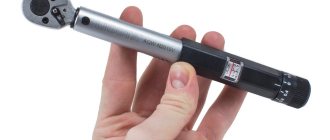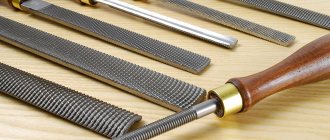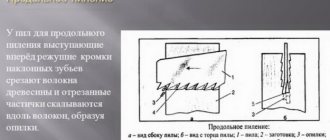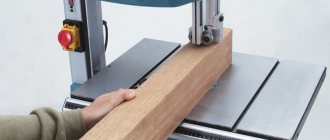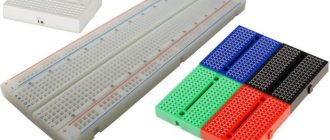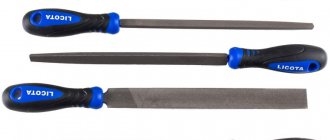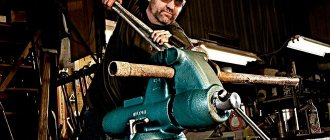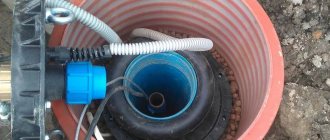One of the main tools for working with various materials for a home craftsman is a hacksaw. It has several varieties, used depending on the type of surface being treated. It is important to know how to use each of them correctly.
What is a hacksaw?
In carpentry, a hacksaw is a special type of hand saw designed for cutting wood, metal, aerated concrete, plastic and other materials. Scientists find mention of the first such instruments in ancient times in the civilizations of Egypt, Greece and Rome. Over the course of its centuries-old history, the hacksaw has undergone significant changes, but has not lost its relevance and is always kept in a set of basic tools for a home craftsman.
Hacksaw device
Like any other carpentry tool, a hacksaw has a certain structure that affects its performance characteristics. It consists of:
- Working, hacksaw or saw blade. It is made of metal of various alloys, which, together with the size, affect the purpose of the tool. Another important parameter of the working blade is the number, shape and size of the teeth. Thanks to them, the surface is divided into parts using the reciprocating movements of the master.
- The working blade is attached and securely fixed to the handle or a special frame. It performs the functions of fixation, protection and ease of use. When selecting a saw, you must take into account its ergonomics.
What is a hacksaw for?
Having understood the definition of what a hacksaw is, it is worthwhile to dwell in more detail on the areas of its application:
- This tool is widely used in gardening for pruning trees and shrubs, cutting down knots and rough parts of wood.
- A hacksaw is used to saw wooden parts during construction and household repairs.
- It is used to cut out figures from plywood, make curved cuts or make through holes.
- There are special varieties for sawing metal sheets and pipes, aerated concrete blocks.
- Some modifications include cutting grooves, tenons and recessed holes.
How is a hacksaw different from a saw?
One of the main and frequently used types of saws is the hacksaw. It differs from other instruments in this group in that:
- This is an exclusively hand tool. The hacksaw saw is driven only by the reciprocating movements of the master’s hands. Whereas other saws can be electric or gasoline.
- When using a hacksaw, only return movements are used, while other saws can be circular.
- In the usual configuration, such a tool has one handle for the master to work alone.
- It has a mostly straight cutting blade, whereas analogues may have a chain, tape or disk.
- A hacksaw has only teeth on the working edge, while other varieties may contain abrasive.
Rules of operation and care
In order for a hacksaw to serve for a long time, you need to take care of it. It is necessary to clean the tool and sharpen it periodically, otherwise it may become completely dull. At the first damage, it is recommended to repair the instrument immediately rather than wait until it falls apart.
Not all saws can be stored for a long time; there are disposable hardened ones. If you need a hacksaw that will last a long time, you need to look at the detailed specifications and determine the best saw for you. One of the most popular is the Japanese hacksaw; it is great for various types of work and can serve for a long time.
Types of hacksaws
The whole variety of hacksaws can be divided into tools for:
- Works with wooden surfaces
. This includes both a universal saw and a garden hacksaw, and some other special varieties. - Treatment of metal surfaces
. This group also has its own modifications for masters of different classes. - Work with aerated concrete
.
The structure of the instrument is:
- Standard with one handle.
- There are modifications with a solid frame.
- A specialized tool is a folding hacksaw, which is an attribute of a traveler's tool kit.
Hacksaw for metal
Often, professional craftsmen use a special carpentry hacksaw for metal, which has the following varieties:
- Classic model with a special frame
. It is often equipped with a rubberized handle for ease of use. Using this model, you can make cuts in sheet metal at angles of 90º and 55º. - Hand hacksaw
. It consists of a special handle to which the equipment is attached only on one side. The special shape of the bracket allows for working in difficult conditions and creating internal cuts.
Wood hacksaw
The largest number of varieties of hacksaws are designed for working with wood. Among them, the popular ones are:
- A classic saw, also called a standard or regular saw. It is a standard tool with a wide cutting blade for straight longitudinal or cross cutting. The number and size of teeth may vary depending on the modification.
- Circular or narrow tool
. It differs from the classic model in that the hacksaw blade is much narrower. This saw is more maneuverable. It is more convenient to cut sheet material along a given contour. - A bow saw has a thin, curved shackle
. This tool is convenient for cutting tree branches and doing other work in the garden. Some varieties have a special connector for attaching a rod for working with high branches. - Passing saw
. It is also called spike or abutment. It is used by carpenters or joiners to remove protruding mortises or tenons, that is, to obtain an even cut.
Hacksaw for aerated concrete
A special type of tool is a hacksaw for foam blocks, specially designed for separating or removing excess parts of aerated concrete. This fragile material requires special tools with hard-melting tips on the teeth. Thanks to this technology it is possible to:
- Extend tool life. Special soldering prevents abrasion and wear of the teeth, making it possible to cut large quantities of aerated concrete.
- A hacksaw for drywall or wood is much sharper, but it cannot be used for foam blocks, since the materials have different densities and rigidities. Special equipment simplifies and speeds up the process of dividing blocks into parts.
- Eliminate the need to buy expensive electric or gas-powered devices for working with gas silicate.
Types of hacksaw teeth
All the models described above differ not only in the shape of the blade for a hacksaw for metal or wood, but also in the size and sharpening angle of the teeth. According to shape and sharpening, all teeth are divided into:
- Equipment for longitudinal sawing along the grain. It is equipped with large teeth sharpened at right angles.
- For cross-cutting layers of workpieces. The edges of the teeth are sharpened at an angle and slightly tilted back.
- The so-called Japanese teeth for cross cutting. They differ from the standard analogue by longer teeth and a double slope of the cutting edge.
- Universal teeth of symmetrical size, sharpened along the edges. Suitable for longitudinal and cross cutting.
The size of the teeth is:
- Small, about 2-2.5 mm long.
- Medium, the size of which is around 3-3.5 mm.
- Teeth with a length of 4-6 mm are considered large.
Tool manufacturers
The segment is highly specialized and in little demand among a wide audience, so not every manufacturer turns to it. The best developments are offered by KRAFTOOL, IRWIN and Bahco. Thus, the first company’s family includes a 320 mm long Multi-M hacksaw with a rounded top. This version is suitable for rigid sheet workpieces made, in particular, from combinations of wood and plastics. IRWIN sells the Xpert XP3055 hacksaw, 300 mm long. The small design with a two-component handle is ergonomic, reliable and safe. As for the Bahco company, its assortment includes the Superior abutment saw with original NXT teeth, which are subjected to high-precision hardening. This model is suitable for medium and small workpieces of varying hardness. A thicker spine increases the durability of thin blades and increases the quality of cutting.
How to choose a hacksaw?
Before choosing in a store which hacksaw is best for wood or other materials, you should find out the basic criteria for purchasing a quality tool that will last a long time and function properly:
- Specialization of the model you like. It is worth carefully selecting what material you will work with. Tools for aerated concrete and gardening are significantly different.
- The grade of steel from which the cutting blade is made. High-speed and carbon alloys with a blade strength of 45 HRC and a cutting edge of at least 60 HRC perform best.
- Sharpening the teeth affects the quality of the cut in a certain direction or when working in hard-to-reach places. The universal sharpening is somewhat inferior in cutting quality to more specialized models.
- The length of the blade varies not only among different types of models, but also differs among tools of the same category.
- Comfortable handle. This parameter is especially important if the master will carry out a large amount of work with the tool. The more comfortable the hacksaw fits in the palm of your hand, the less your hand will get tired.
Cordless hacksaw
A special type of tool that has appeared relatively recently is the cordless reciprocating saw, which is also called an electric hacksaw. This device is useful when performing a large number of construction or gardening works. Its compact size allows you to use the electric hacksaw in confined spaces that would be difficult to handle with a conventional saw. Such a hacksaw should be selected based on its following characteristics:
- Battery capacity, which directly affects the operating time without recharging. Professional models can last about 5 hours before changing the battery.
- Voltage that affects the power and number of movements made by the saw per unit time.
- Possibility of connecting additional batteries to increase performance.
Hacksaw rating
Before purchasing a carpentry tool, you should pay attention to reviews from professionals and home craftsmen who have already assessed the quality of work with a particular hacksaw. The ranking of the most popular saws with excellent reviews includes:
- Gross Piranha 24101
is one of the best classic professional woodworking models with a comfortable handle from a German company with production in China. Cost – $20. - Vira 800240
is a high-quality domestic saw with three-sided teeth sharpening and additional hardening. High quality at a modest cost of about $7. - Stanley 1-15-122
– frame metal saw with a comfortable handle. Price – $8. - Stayer Max Cut
is a convenient folding type of woodworking tool that many hunters and tourists prefer to take with them. Price – $7. - Irwin 10505549
is a specialized tool for professional masons for working with aerated concrete blocks. Price – $24.
Features of the instrument
The design of the saw is formed by the same basic components - a cutting metal blade and a handle. The fundamental feature of the device can be called the presence of that same pad. This is an overhead part on the top of the canvas that acts as a stiffener. What is this add-on for? A traditional hacksaw produces slight vibrations in the blade during the sawing process, which slow down the work and can affect the quality of the result. In order to minimize “hanging”, manufacturers increase the rigidity of the canvas by increasing its thickness. The negative effect of such a change in parameters will be the expansion of the cutting area, which is unacceptable in the delicate processing of small structures and parts. In turn, the back saw, precisely due to the additional device with increased rigidity, eliminates the effect of vibration, while maintaining a moderate thickness of the blade. This tool is also distinguished by a small, hardened tooth, which allows it to perform precise and neat cuts.
How to use a hacksaw?
The principles of working with basic plumbing tools, which include a hand saw, are simple, but failure to follow them can lead to a broken saw or a poor-quality cut. Main rules for handling the tool:
- The master takes a comfortable standing position with firm emphasis on his legs. Your elbows should bend at an angle of 90º.
- Reliable fixation of the sawn surface. If possible, it is better to secure the material in a vice.
- The hacksaw blade is firmly positioned strictly perpendicular to the surface. It is important to eliminate all vibrations of the instrument to prevent damage.
- Tools for metal are held with two hands, while tools for wood or aerated concrete are held with one.
Selection rules
If you will be using the saw for gardening work, a regular utility saw will do. If you are working with material that requires high-quality processing, then a saw with small teeth is suitable. For complex plumbing work, you will need a bow saw. The price of a good tool cannot be too low. If you want your hacksaw to serve you faithfully for a long time, then it is better to buy a more expensive tool and preferably from a well-known company. If possible, look through the reviews and look at the ratings of different types of saws, then choosing a good tool will not be difficult for you.
How to sharpen a hacksaw?
After carrying out a certain amount of work with a hacksaw, the saw teeth simply become dull. The first signs of the need for sharpening include:
- Heavy and uneven cutting.
- Uneven cut.
- The blade often gets stuck.
- It is difficult to maintain a given trajectory.
When the above “symptoms” appear, every master should understand how to sharpen a hacksaw while maintaining the working profile of the teeth:
- Securely fix the tool in a vice or clamp.
- Set the teeth. This procedure involves alternately bending each tooth in different directions by the same amount, approximately 1.5-2 mm, with a special tool.
- A triangular file with a fine notch is selected.
- The sharpening angle of the teeth is determined by eye, which is approximately 15-30º.
- Carry out the same number of file movements in the selected direction on one side. Repeat the process for the other side.
- The teeth are aligned in height.
Dimensions and material of the canvas
High-quality canvas is made of steel. It is better to use stainless steel. Hacksaw teeth can be hardened or regular. The difference between hardened and regular ones is that they cannot be restored after wear. Regular saw teeth can be sharpened.
The canvas size can be as follows:
- mini - available in a length of no more than 35 cm, has a large number of small teeth;
- standard - has a length of no more than 55 cm, the teeth are at an average distance from each other;
- wide saw no more than 60 cm long, teeth with increased pitch.
When choosing a size, you should be guided by the purpose for which the tool is intended.

